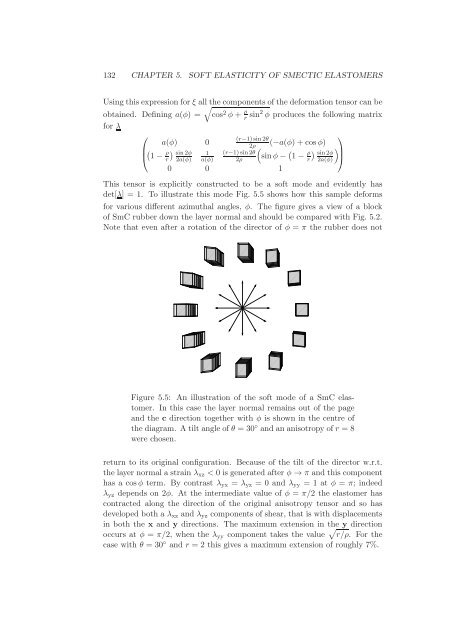Statistical models of elasticity in main chain and smectic liquid ...
Statistical models of elasticity in main chain and smectic liquid ...
Statistical models of elasticity in main chain and smectic liquid ...
You also want an ePaper? Increase the reach of your titles
YUMPU automatically turns print PDFs into web optimized ePapers that Google loves.
132 CHAPTER 5. SOFT ELASTICITY OF SMECTIC ELASTOMERSUs<strong>in</strong>gthisexpressionforξ all √thecomponents<strong>of</strong>thedeformation tensorcanbeobta<strong>in</strong>ed. Def<strong>in</strong><strong>in</strong>g a(φ) = cos 2 φ+ ρ r s<strong>in</strong>2 φ produces the follow<strong>in</strong>g matrixfor λ⎛(r−1)s<strong>in</strong>2θ⎞a(φ) 02ρ(−a(φ)+cosφ)⎜( ⎝ 1−ρ) (s<strong>in</strong>2φ 1 (r−1)s<strong>in</strong>2θr 2a(φ) a(φ) 2ρs<strong>in</strong>φ− ( 1− ρ ) )s<strong>in</strong>2φ ⎟⎠r 2a(φ)0 0 1This tensor is explicitly constructed to be a s<strong>of</strong>t mode <strong>and</strong> evidently hasdet[λ] = 1. To illustrate this mode Fig. 5.5 shows how this sample deformsfor various different azimuthal angles, φ. The figure gives a view <strong>of</strong> a block<strong>of</strong> SmC rubber down the layer normal <strong>and</strong> should be compared with Fig. 5.2.Note that even after a rotation <strong>of</strong> the director <strong>of</strong> φ = π the rubber does notFigure 5.5: An illustration <strong>of</strong> the s<strong>of</strong>t mode <strong>of</strong> a SmC elastomer.In this case the layer normal rema<strong>in</strong>s out <strong>of</strong> the page<strong>and</strong> the c direction together with φ is shown <strong>in</strong> the centre <strong>of</strong>thediagram. A tilt angle <strong>of</strong> θ = 30 ◦ <strong>and</strong> an anisotropy <strong>of</strong> r = 8were chosen.return to its orig<strong>in</strong>al configuration. Because <strong>of</strong> the tilt <strong>of</strong> the director w.r.t.the layer normal a stra<strong>in</strong> λ xz < 0 is generated after φ → π <strong>and</strong> this componenthas a cosφ term. By contrast λ yx = λ yz = 0 <strong>and</strong> λ yy = 1 at φ = π; <strong>in</strong>deedλ yz depends on 2φ. At the <strong>in</strong>termediate value <strong>of</strong> φ = π/2 the elastomer hascontracted along the direction <strong>of</strong> the orig<strong>in</strong>al anisotropy tensor <strong>and</strong> so hasdeveloped both a λ xz <strong>and</strong> λ yz components <strong>of</strong> shear, that is with displacements<strong>in</strong> both the x <strong>and</strong> y directions. The maximum extension <strong>in</strong> the y directionoccurs at φ = π/2, when the λ yy component takes the value √ r/ρ. For thecase with θ = 30 ◦ <strong>and</strong> r = 2 this gives a maximum extension <strong>of</strong> roughly 7%.
















